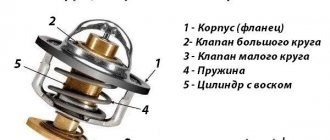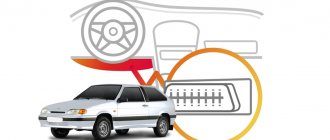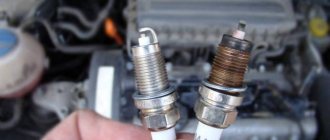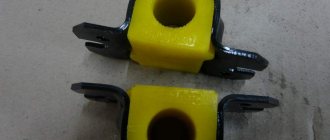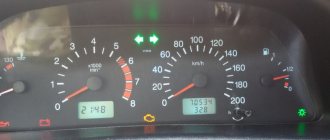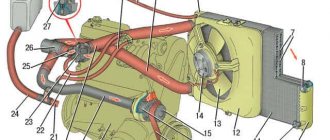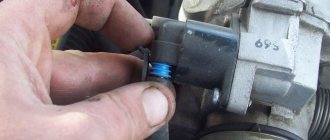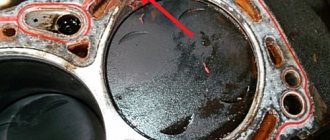Cars in Russia are now equipped with a variety of electronic control devices. In this sense, the VAZ-2115 is no exception - it is equipped with various sensors. What are their purposes and possible malfunctions are described in this article.
If any problem occurs in the engine, an alarm light immediately lights up on the instrument panel in the cabin. In a situation where the malfunction is minor, it goes out approximately a second after the power unit starts. This is approximately the amount of time it takes for the on-board computer to carry out diagnostics.
If the breakdown is serious enough, the ECU signals this by issuing certain error codes. So:
- 2 means that problems have arisen with the fuel level sensor;
- 13 – no information on air quality;
- 14-15 – antifreeze level is not controlled;
- 19 – incorrect readings from the crankshaft sensor;
- 21-22 – problems with the throttle valve;
- 23-25 – the device recording the air temperature has failed;
- 24 – speed meter does not work;
- 33-34 – problems with the mass air flow sensor;
- 35 – idle speed control is knocked down;
- 43 – failure of the knock sensor;
- 61 – data is not supplied from the device that measures the oxygen level.
Knowing the codes allows you to quickly resolve problems.
Sensor layout
The sensors under the hood of the VAZ 2115 are located as follows.
1. Phase sensor; 2. Coolant temperature sensor; 3. Knock sensor; 4. Oil pressure sensor; 5. Oxygen sensor; 6. Crankshaft position sensor; 7. Speed sensor; 8. Idle speed sensor; 9. Mass air flow sensor; 10-11. Gasoline level sensor; 12. Antifreeze level sensor; 13. Throttle position sensor
List of devices
Sensors are needed to report on the performance of systems, signal the level of cooling liquids and oil, and prevent or anticipate emergency situations.
These small devices, despite their size, play an incredible role in the performance of the machine. Therefore, it will not be superfluous to know which sensors are on your car.
Let us list the main ones present in the VAZ 2114 systems. We include sensors in this list:
Coolant temperature;
Coolant level in the expansion tank;
Mass air flow rate indicator;
Engine idling;
Brake fluid level in the system;
Camshaft position (it is called a phase sensor);
Outside air temperature;
Uneven road surface.
This list is very, very extensive. But even this, the owners of the VAZ 2114 do not want to stop, which is why they are introducing several more different sensors into the system:
- Light devices;
- Reverse;
- A device that signals open doors;
- Brake pad wear indicator, etc.
Electronic engine control unit
The engine control unit is a kind of head control center for the entire car. This device processes all the readings provided by the vehicle’s sensors, regulates the engine control process, determines the required fuel and air ratios, generates a spark supply to the desired cylinder, and much more. The ECU is located inside the car, under the dashboard.
Speeds
Machine speed signals are transmitted to the control unit using pulse signals. As a rule, for one kilometer traveled by a car, the device transmits about 6 thousand impulses. The speed of the machine is determined by the on-board computer, taking into account the purity of the pulses received. Ultimately, the data obtained is used to adjust the speed of the power unit when idling. When the device fails, it leads to an increase in fuel consumption, especially when driving at idle speed. In this case, the engine power will be reduced, and the speedometer will also refuse to work.
Mass air flow sensor
Mass air flow sensor is one of the most expensive sensors in a car. It is responsible for counting the air passing through it. These readings are necessary for proper mixing of air and fuel. The flow meter can fail if the air filter is not replaced for a long time, as well as with strong ventilation of crankcase gases due to the high content of oil combustion products in the internal combustion engine. It is located on the air filter housing and is attached to it with two bolts.
Signs of malfunction:
- Uneven idle speed;
- Increased fuel consumption;
- Long start of the internal combustion engine;
Mass air flow sensor
This monitoring device monitors the level of mass air flow. It is based on a platinum thread, cooled by the atmosphere. It is then heated with electricity. Depending on the voltage consumed, the current fuel and air consumption is calculated. If it fails, then the ECU replaces its readings with data coming from the DPZD and DPKV.
The failure of this sensor manifests itself:
- too much fuel consumption;
- unstable engine operation at idle;
- sudden stop after increasing power;
- problems with starting.
The easiest way to determine its malfunction is to replace it with a known working device.
Phase sensor
It is responsible for adjusting fuel injection only into the cylinder that is in the compression stroke, that is, fuel is supplied only through one injector to one cylinder. It is oriented along the camshaft, which is why it is called the camshaft position sensor. It works according to the Hall principle, producing an electrical impulse when a magnetic field is excited. If the VAZ 2115 phase sensor fails, fuel is supplied according to the principle of carburetor engines - into two cylinders at once. The result is a set of faults.
Symptoms of malfunction
The DPRV is located in the same place as the camshaft gear, on the cylinder head. The main symptom of the malfunction is high fuel consumption and loss of power. In addition, the computer displays error 0340 (sensor error) or 0343 (pulse level too high).
Examination
The malfunction of the DPRV can be judged by the error code and the burning CE lamp, but you can verify its functionality by checking the voltage at the power terminal A (12 V). The remaining terminals must not be live.
DTOZH
It signals the temperature of the antifreeze and is, in fact, a thermistor. That is, the more it heats up, the more its resistance drops. The sensor is located near the cylinder head and next to the thermostat. Its signal goes to both the on-board computer and the radiator fan.
It is often confused with a temperature sensor, but the purpose of the latter is to transmit information only to the dashboard.
DTOZH very rarely fails. The following troubles are more likely to happen to him:
- broken contact inside;
- destruction of insulation;
- rupture of the supply wires (they are most often caught by the throttle cable located in the immediate vicinity).
Failure of the DTOZh leads to the fact that the ECU believes that the engine temperature is zero degrees and sends the corresponding command to the air pumping regulator. In this situation, the fuel supply will not be optimal - as a result, problems with starting the engine in cold weather will arise. At the same time, after the engine starts running, after two minutes the computer will report that the antifreeze has heated to 80 degrees Celsius.
In hot weather, when the car is stuck in a traffic jam, a faulty DTS can cause other serious problems. In particular, the ECU will assume that the coolant temperature remains normal and, therefore, will not recalculate the ignition timing. As a result, the power will drop and the engine will stall.
Crankshaft Positions
The VAZ crankshaft sensor is an element that allows you to transmit signals to the on-board computer about the position of the crankshaft. The performance of the combustible mixture supply systems, as well as the ignition system, depends on how this element works. And if we are talking about an injector, then the DPKV determines the functionality of the injectors.
This element is often called a synchronization regulator, since the control unit, having received data from it, detects the required moment of gasoline injection into the engine cylinders. If the device breaks down, the on-board computer will begin to transmit incorrect data, which will subsequently lead to malfunctions of the gasoline supply system. Accordingly, normal operation of the injectors will be impossible. The regulator itself is located next to the camshaft and the generator belt.
TPDZ
This is a sensor that records the position of the throttle valve. Its readings are needed so that the on-board computer can calculate:
- fuel injection duration;
- ignition timing advance angle;
- operating mode of the entire power plant;
- acceleration moment, etc.
If this device provides, then the information recorded by it is replaced by data from the DPKV and DMRV. The breakdown is usually accompanied by unstable engine operation.
In VAZ cars, this control device is a polymer film coated with graphite. In general, practice shows that it is this sensor that most often breaks down.
The car in this case:
- moves jerkily;
- braking by the power plant is often absent;
- There are “dips” during acceleration.
At the same time, the "Check Engine" light often does not turn on. The ECU detects a failure only if a short circuit occurs, but when the graphite tracks are partially worn out, the diagnosis has no effect. Complete loss of contact leads to the fact that the idle speed of the car is kept at a maximum of 1.5 thousand revolutions.
Sometimes there is a change in the readings of this monitoring device within the range of up to 5 percent when the gas is released. At the same time, the computer will believe that the driver is pressing the previously mentioned pedal with full force - as a result, the idle speed begins to “float” randomly. With such a problem, driving a car is simply dangerous.
DPKV
This sensor tells the ECU the current position of the crankshaft. It is inductive, that is, when the above node rotates, it produces certain impulses, the frequency of which allows the computer to make the necessary calculation. If the signal is lost, the power unit stops. That is, its malfunction will not even allow you to get to a car service center. Otherwise, it breaks very rarely.
In this situation, the ECU will show an error code - 0335. However, this does not always mean that it is the DPKV that has become unusable. Sometimes the same combination appears if the mass air flow sensor is not working properly.
Idle move
As you can already understand, almost all controllers on the VAZ 2115 are designed to read information. But the idle speed controller not only transmits data, but also represents a regulatory element that in one way or another affects the operation of the power unit in idle mode. You can learn more about diagnosing device malfunctions, as well as replacing it, from the video below (the author of the video is Ivan Vasilyevich).
The DXX is equipped with an electric drive, as well as a special conical needle installed in such a way that it fits into the throttle line. When the car is idling or standing still, the regulator changes the position of this needle, according to which the line opens or closes. Ultimately, the air that enters the throttle assembly is adjusted. There is a special place for installing the controller in the throttle, so you can easily find it if necessary - the device is attached to the line with two bolts.
Fuel level sensor
Indicates the remaining amount of fuel in the tank. Installed directly in the tank on the fuel pump glass. It fails when the graphite contacts on the electrical board are rubbed. When replacing, you should pay attention to its type number, which is indicated on the board, since all types of FLS have different resistance. If an unsuitable sensor is installed, large errors in readings may occur.
Signs of malfunction:
- Incorrect readings about the presence of fuel in the tank;
Knock sensor
Responsible for capturing noise from the engine and transmitting readings to the ECU. The principle of operation of a piezo element is reminiscent. When detonation occurs in the internal combustion engine, it generates a small voltage and transmits readings to the head engine control unit, thereby adjusting the fuel mixture. Installed on the cylinder block between the two middle cylinders.
Signs of malfunction:
- Clattering of fingers under load;
- Increased consumption;
Oxygen
The oxygen regulator is popularly called a lambda probe. This controller is designed to transmit data to the ECU about how much oxygen is contained in the exhaust gases. The element is located in the muffler receiving line, next to the resonator device. If the car's regulator breaks down, it will begin to twitch when driving, so if signs of a malfunction appear, the device needs to be replaced.
Six oxygen devices for cars
Coolant temperature sensor
It is installed in the thermostat housing and is responsible for automatically turning the cooling fan on and off. The sensor is also responsible for adjusting the fuel mixture during a cold start; this can be noticed when starting the car in cold weather, with increased idle speed.
Signs of malfunction:
- The fan does not work;
- There are no warm-up speeds;
Communities › VAZ: Repair and Improvement › Forum › E - gas for 2114
Good day to all. Such a disaster happened. I have a 2114 produced in 2011, respectively, with an electronic gas pedal. Well, the problem is this: it’s hard to start in the morning when it’s cold. You start to start it, it starts and immediately stalls. Only if you give a little gas, then it will start... It also happens during the day that it shows off and doesn’t start the first time... Diagnostics did not show anything... The service center said that this is a problem due to the electric throttle. Winter is approaching, and I'm worried that the car won't start when it starts, and therefore will freeze.
Oil pressure sensor
Oil pressure is an important indicator in engine operation; if it is absent, the internal combustion engine will not be lubricated, which will lead to engine failure. This sensor informs the driver about the presence or absence of pressure in the internal combustion engine lubrication system. The sensor is installed on the cylinder head housing and is mechanical.
Signs of malfunction:
- No oil pressure;
- The oil pressure indicator does not light up;
Where are they located?
But knowing about their presence in your VAZ 2114 car is not enough. In case of problems, when the electronic control unit receives incorrect data from signaling devices, they have to be changed.
Whatever one may say, every sensor that has ceased to function properly and transmit correct data on the state of the systems to the electronic control unit must be replaced. Almost all sensors cost no more than a few hundred rubles. But even low cost and small size do not indicate the uselessness of these devices. Change devices promptly.
To do this, you need to understand how to get to this or that sensor. Therefore, we invite you to familiarize yourself with the location of key alarm and measurement devices.
On 8 valve engines it is located at the bottom of the valve cover in the cylinder head, and on 16 valve engines it is located on the left end of the camshaft bearing housing
Coolant temperature (engine temperature sensor)
Look for it near the tasty cylinder head cooling jacket pipe
Coolant level
It is located directly on the tank, inside of which there is coolant (antifreeze or antifreeze). Looks like a simple plastic cover that connects to an electrical connector
Brake fluid level
This is a float device located inside the brake fluid reservoir.
Idle speed (IAC)
Look near the throttle valve on the throttle body
Mass air flow
You will find it near the large intake pipe, directly on the air filter housing
Throttle Positions
Located on the throttle body
Crankshaft position (timing sensor)
Its location is near the electric generator drive pulley
Camshaft position (phase sensor)
Near the cylinder head cover, viewed from the air filter side
Oxygen (lambda probe)
Installed in front of the resonator in the intake manifold of the exhaust system
Located between cylinders 2 and 3 near the fan
It should be looked for inside the intake chamber of the fuel tank
Located directly on the gearbox
Look near the cup on the side of the right mudguard. You can get there through the engine compartment
Ambient temperatures
It is installed directly behind the front bumper, exactly in the middle
Each sensor has its own strictly designated place. Having studied their locations, you can easily replace devices in the event of breakdowns or malfunctions.
Some measuring and signaling devices are located literally on the surface, so there is no need to carry out additional dismantling work. To get to others, you will have to seriously dig into your VAZ 2114 and remove quite a few parts.
The integrity of your car, the safety of the driver, passengers and all other road users depend on their performance. Therefore, treat the sensors with appropriate respect, monitor their condition and change them in a timely manner if the need arises.
Several malfunctions that are often found on cars of the 2115 family.
Cooling system
If a malfunction occurs in the cooling system, pull off the road and stop the engine.
Open the hood and carefully inspect the engine compartment. If steam escapes, we determine a specific location. We inspect the engine, check the expansion tank for the position of the coolant level. In one step, we determine the condition of the thermostat, radiator, and rubber hoses in the engine cooling system.
Do not unscrew the expansion tank cap immediately after stopping the engine. In the cooling system, the liquid is under high pressure. When we unscrew the plug, the pressure drops sharply, and according to the laws of physics, the coolant boils. Naturally, its splashes can lead to burns to your hands and face. If there is an urgent need to unscrew the expansion tank cap on an engine that has not yet cooled down, you need to throw some thick fabric on top and only then slowly unscrew the cap.
Let’s not be too lazy to look under the instrument panel of the VAZ-2115. Underneath it, you may find leaks of coolant oozing from the heater or radiator tap.
If coolant leaks are caused by a burst hose, it can be temporarily patched with adhesive tape (duct tape, tape).
There are much more problems if the leak comes from the heater, radiator or thermostat. It is difficult to eliminate it along the way. In this situation, it is recommended to add water to the cooling system and monitor the temperature readings while driving. If necessary, the level in the cooling system will have to be restored periodically. Please note that if you use water instead of antifreeze for a long time, this will most likely provoke the formation of scale in the cooling system of the VAZ-2115. As a result, cooling will deteriorate and engine life will decrease. Therefore, after an emergency trip, be sure to fix the leak, drain the liquid diluted with water, flush the system and fill with fresh coolant. The most important condition is that it is prohibited to add cold water to an overheated engine! The engine must cool for at least half an hour with the hood open.
If the VAZ 2115 cooling system is faulty and no coolant leak is observed, check the integrity of fuse No. 5 (20A). It performs the function of forced protection of the on-board power circuit in the electric fan of the cooling system. The fuse is located in the mounting block located in the engine compartment. If the electric motor starts working after replacing the fuse, the journey can continue.
If the electric motor does not work after replacing the fuse, we will conduct additional diagnostics. Let's take two additional wires and supply power to the electric motor directly from the battery.
Please note that the wires must be insulated and securely fastened. Short circuits between wires must not be allowed! Be sure to pay attention to the polarity of the connection: the electric motor must rotate in such a way that the fan forces air onto the engine through the radiator, and the directions of the oncoming (path) air flow and the air flow generated by the fan coincide.
If the electric motor starts working after these manipulations, it means that the electrical wiring of the cooling system or the fan relay is faulty. The relay is located under the trim on the right side of the dashboard console of the VAZ 2115. If the engine is silent, there may be a malfunction of the electric motor itself or the wiring. Unfortunately, neither the electric motor nor the relay can be repaired and will require replacement.
The engine can also overheat if the thermostat fails. This unit regulates the flow of fluid through the cooling system either bypassing the radiator (to speed up the warm-up of a cold engine) or through the radiator. Checking the thermostat is not difficult: on a warm engine, we feel the lower hose connecting the radiator and the engine. If the hose is cold, the thermostat is most likely faulty, so coolant is not circulating through the radiator.


